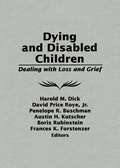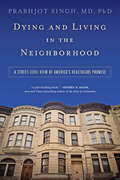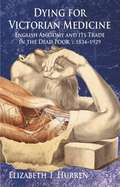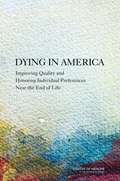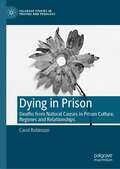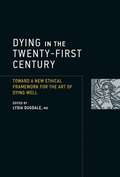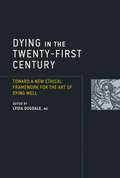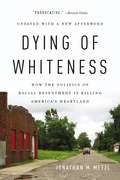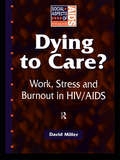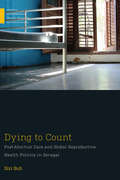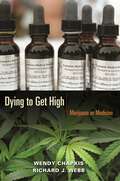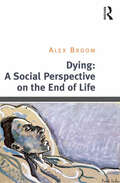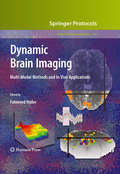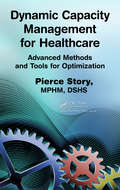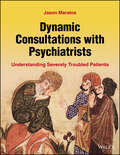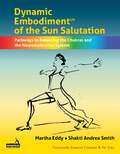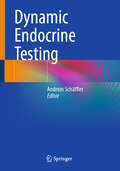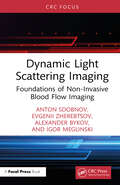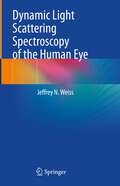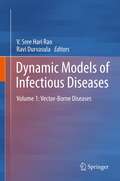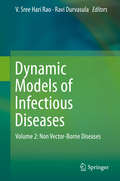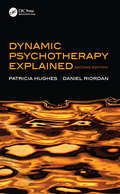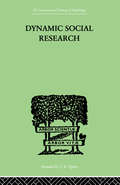- Table View
- List View
Dying and Disabled Children: Dealing With Loss and Grief
by Jr. Austin H. Kutscher David Price Roye Harold M. Dick Penelope R. Buschman Boris Rubinstein Francis K. ForstenzerIn this sensitive and compassionate look at terminally ill and disabled children, professionals from the medical community examine the stresses faced by their parents and siblings. They address the crucial element of communication--within a family and between health care providers and family members--in dealing with a child’s serious illness. Ethical decision making, learning to recognize the child’s suffering, and talking to children about death are honestly and clearly discussed. Experts offer direct interventions to help family members through the grieving process once a child has died.
Dying and Living in the Neighborhood: A Street-Level View of America’s Healthcare Promise
by Prabhjot SinghHave neighborhoods been left out of the seismic healthcare reform efforts to connect struggling Americans with the help they need?Even as US spending on healthcare skyrockets, impoverished Americans continue to fall ill and die of preventable conditions. Although the majority of health outcomes are shaped by non-medical factors, public and private healthcare reform efforts have largely ignored the complex local circumstances that make it difficult for struggling men, women, and children to live healthier lives. In Dying and Living in the Neighborhood, Dr. Prabhjot Singh argues that we must look beyond the walls of the hospital and into the neighborhoods where patients live and die to address the troubling rise in chronic disease. Building on his training as a physician in Harlem, Dr. Singh draws from research in sociology and economics to look at how our healthcare systems are designed and how the development of technologies like the Internet enable us to rethink strategies for assembling healthier neighborhoods. In part I, Singh presents the story of Ray, a patient whose death illuminated how he had lived, his neighborhood context, and the forces that accelerated his decline. In part II, Singh introduces nationally recognized pioneers who are acting on the local level to build critical components of a neighborhood-based health system. In the process, he encounters a movement of people and organizations with similar visions of a porous, neighborhood-embedded healthcare system. Finally, in part III he explores how civic technologies may help forge a new set of relationships among healthcare, public health, and community development.Every rising public health leader, frontline clinician, and policymaker in the country should read this book to better understand how they can contribute to a more integrated and supportive healthcare system.
Dying for Victorian Medicine
by Elizabeth T. HurrenIn the nineteenth century the business of anatomy was very profitable. However, existing in a Victorian underworld, its shadowy details and potential links to the Jack-the-Ripper murders were seldom exposed. In this accessible and vibrant account, Elizabeth Hurren brings to life lost pauper stories recovered from the asylums, infirmaries, workhouses, body dealers, railway men and undertakers that supplied the medical profession with dissection subjects. The details of those trading networks, corpse sales, body parts fees, railway transportation costs and funeral expenses have never been documented before now, yet this economy of supply in the dead underpinned modern medicine. In Dying for Victorian Medicine, Hurren allows us to look for the first time into the human face of abject poverty, working back in the archives from death to touch the lives of those compelled by pauperism to give up a loved one's body for dissection.
Dying in America: Improving Quality and Honoring Individual Preferences Near the End of Life
by Committee on Approaching Death: Addressing Key End of Life IssuesFor patients and their loved ones, no care decisions are more profound than those made near the end of life. Unfortunately, the experience of dying in the United States is often characterized by fragmented care, inadequate treatment of distressing symptoms, frequent transitions among care settings, and enormous care responsibilities for families. According to this report, the current health care system of rendering more intensive services than are necessary and desired by patients, and the lack of coordination among programs increases risks to patients and creates avoidable burdens on them and their families. Dying in America is a study of the current state of health care for persons of all ages who are nearing the end of life. Death is not a strictly medical event. Ideally, health care for those nearing the end of life harmonizes with social, psychological, and spiritual support. All people with advanced illnesses who may be approaching the end of life are entitled to access to high-quality, compassionate, evidence-based care, consistent with their wishes. Dying in America evaluates strategies to integrate care into a person- and family-centered, team-based framework, and makes recommendations to create a system that coordinates care and supports and respects the choices of patients and their families. The findings and recommendations of this report will address the needs of patients and their families and assist policy makers, clinicians and their educational and credentialing bodies, leaders of health care delivery and financing organizations, researchers, public and private funders, religious and community leaders, advocates of better care, journalists, and the public to provide the best care possible for people nearing the end of life.
Dying in Prison: Deaths from Natural Causes in Prison Culture, Regimes and Relationships (Palgrave Studies in Prisons and Penology)
by Carol RobinsonThis book uses empirical data gathered using ethnographic methods in two contrasting prisons to provide a rare insight into death and dying in prisons in the UK. The majority of deaths in prison custody in England and Wales result from natural causes, yet the experiences of people dying in prison and the impact of these deaths on the wider prison are under-researched areas. It provides a novel insight into the impact of deaths from natural causes on the prison as an institution and challenges existing work juxtaposing occupational philosophies of ‘care’ and ‘control’. It also identifies how end of life care is provided in prisons and the impact this has on culture and relationships shows how deaths from natural causes in prison custody ‘soften’ prison regimes, culture and relationships. It speaks to an international audience by drawing on the global literature including from the US.
Dying in the Twenty-First Century
by Lydia DugdaleMost of us are generally ill-equipped for dying. Today, we neither see death nor prepare for it. But this has not always been the case. In the early fifteenth century, the Roman Catholic Church published the Ars moriendi texts, which established prayers and practices for an art of dying. In the twenty-first century, physicians rely on procedures and protocols for the efficient management of hospitalized patients. How can we recapture an art of dying that can facilitate our dying well? In this book, physicians, philosophers, and theologians attempt to articulate a bioethical framework for dying well in a secularized, diverse society. Contributors discuss such topics as the acceptance of human finitude; the role of hospice and palliative medicine; spiritual preparation for death; and the relationship between community, and individual autonomy. They also consider special cases, including children, elderly patients with dementia, and death in the early years of the AIDS epidemic, when doctors could do little more than accompany their patients in humble solidarity.These chapters make the case for a robust bioethics -- one that could foster both the contemplation of finitude and the cultivation of community that would be necessary for a contemporary art of dying well. ContributorsJeffrey P. Bishop, Lisa Sowle Cahill, Daniel Callahan, Farr A. Curlin, Lydia S. Dugdale, Michelle Harrington, John Lantos, Stephen R. Latham, M. Therese Lysaught, Autumn Alcott Ridenour, Peter A. Selwyn, Daniel Sulmasy
Dying in the Twenty-First Century: Toward a New Ethical Framework for the Art of Dying Well (Basic Bioethics)
by Lydia DugdalePhysicians, philosophers, and theologians consider how to address death and dying for a diverse population in a secularized century.Most of us are generally ill-equipped for dying. Today, we neither see death nor prepare for it. But this has not always been the case. In the early fifteenth century, the Roman Catholic Church published the Ars moriendi texts, which established prayers and practices for an art of dying. In the twenty-first century, physicians rely on procedures and protocols for the efficient management of hospitalized patients. How can we recapture an art of dying that can facilitate our dying well? In this book, physicians, philosophers, and theologians attempt to articulate a bioethical framework for dying well in a secularized, diverse society.Contributors discuss such topics as the acceptance of human finitude; the role of hospice and palliative medicine; spiritual preparation for death; and the relationship between community, and individual autonomy. They also consider special cases, including children, elderly patients with dementia, and death in the early years of the AIDS epidemic, when doctors could do little more than accompany their patients in humble solidarity.These chapters make the case for a robust bioethics—one that could foster both the contemplation of finitude and the cultivation of community that would be necessary for a contemporary art of dying well.ContributorsJeffrey P. Bishop, Lisa Sowle Cahill, Daniel Callahan, Farr A. Curlin, Lydia S. Dugdale, Michelle Harrington, John Lantos, Stephen R. Latham, M. Therese Lysaught, Autumn Alcott Ridenour, Peter A. Selwyn, Daniel Sulmasy
Dying of Whiteness: How the Politics of Racial Resentment Is Killing America's Heartland
by Jonathan M. MetzlA physician's "provocative" (Boston Globe) and "timely" (Ibram X. Kendi, New York Times Book Review) account of how right-wing backlash policies have deadly consequences -- even for the white voters they promise to help. In election after election, conservative white Americans have embraced politicians who pledge to make their lives great again. But as physician Jonathan M. Metzl shows in Dying of Whiteness, the policies that result actually place white Americans at ever-greater risk of sickness and death. Interviewing a range of everyday Americans, Metzl examines how racial resentment has fueled progun laws in Missouri, resistance to the Affordable Care Act in Tennessee, and cuts to schools and social services in Kansas. He shows these policies' costs: increasing deaths by gun suicide, falling life expectancies, and rising dropout rates. Now updated with a new afterword, Dying of Whiteness demonstrates how much white America would benefit by emphasizing cooperation rather than chasing false promises of supremacy.Winner of the Robert F. Kennedy Book Award
Dying to Care: Work, Stress and Burnout in HIV/AIDS Professionals (Social Aspects of AIDS)
by David MillerBased on major multi-centre research in the UK, Dying to Care identifies why work stress is a problem in health care generally, and in HIV health care in particular. The similarities and differences between work stress experienced in general health care settings and in HIV/AIDS are explored in a state-of-the-art review of research and experience in the field to date. The book has a practical focus, and goes on to explore ways in which the unique stresses of patient advocacy in HIV/AIDS can be addressed, identifying the best approaches for management. Highlighting the practical importance of a clear distinction between the burnout and work stress for design of strategies for burnout prevention, the emergence of the concept of burnout is described and the general historical confusion between work stress and burnout examined. This will be a key handbook for managers, physicians, nurses, social workers, health advisors and counsellors working in or alongside healthcare.
Dying to Count: Post-Abortion Care and Global Reproductive Health Politics in Senegal (Medical Anthropology)
by Siri SuhDuring the early 1990s, global health experts developed a new model of emergency obstetric care: post-abortion care or PAC. In developing countries with restrictive abortion laws and where NGOs relied on US family planning aid, PAC offered an apolitical approach to addressing the consequences of unsafe abortion. In Dying to Count, Siri Suh traces how national and global population politics collide in Senegal as health workers, health officials, and NGO workers strive to demonstrate PAC’s effectiveness in the absence of rigorous statistical evidence that the intervention reduces maternal mortality. Suh argues that pragmatically assembled PAC data convey commitments to maternal mortality reduction goals while obscuring the frequency of unsafe abortion and the inadequate care women with complications are likely to receive if they manage to reach a hospital. At a moment when African women face the highest risk worldwide of death from complications related to pregnancy, birth, or abortion, Suh’s ethnography of PAC in Senegal makes a critical contribution to studies of global health, population and development, African studies, and reproductive justice.
Dying to Get High: Marijuana as Medicine
by Wendy Chapkis Richard J. WebbAn inside look at how patients living with terminal illness created one of the country’s first medical marijuana collectivesMarijuana as medicine has been a politically charged topic in this country for more than three decades. Despite overwhelming public support and growing scientific evidence of its therapeutic effects (relief of the nausea caused by chemotherapy for cancer and AIDS, control over seizures or spasticity caused by epilepsy or MS, and relief from chronic and acute pain, to name a few), the drug remains illegal under federal law. In Dying to Get High, noted sociologist Wendy Chapkis and Richard J. Webb investigate one community of seriously-ill patients fighting the federal government for the right to use physician-recommended marijuana. Based in Santa Cruz, California, the Wo/Men’s Alliance for Medical Marijuana (WAMM) is a unique patient-caregiver cooperative providing marijuana free of charge to mostly terminally ill members. For a brief period in 2004, it even operated the only legal non-governmental medical marijuana garden in the country, protected by the federal courts against the DEA.Using as their stage this fascinating profile of one remarkable organization, Chapkis and Webb tackle the broader, complex history of medical marijuana in America. Through compelling interviews with patients, public officials, law enforcement officers and physicians, Chapkis and Webb ask what distinguishes a legitimate patient from an illegitimate pothead, good drugs from bad, medicinal effects from just getting high. Dying to Get High combines abstract argument and the messier terrain of how people actually live, suffer and die, and offers a moving account of what is at stake in ongoing debates over the legalization of medical marijuana.
Dying: A Selection from Waking, Dreaming, Being: Self and Consciousness in Neuroscience, Meditation, and Philosophy (To the Point)
by Evan ThompsonIn the ancient Indian epic, Mahabharata, the Lord of Death asks, "What is the most wondrous thing in the world?", and his son answers, "It is that all around us people can be dying and we don't believe it can happen to us." This refusal to face the inevitability of death is especially prevalent in modern Western societies. We look to science to tell us how things are but biomedicine and neuroscience divest death of any personal significance by presenting it as just the breakdown of the body and the cessation of consciousness. The Tibetan Buddhist perspective stands in sharp contrast to this modern scientific notion of death. This tradition conceives dying not as the mere termination of living processes within the body, but as a rite of passage and transformation of consciousness. Physical death, in this tradition, initiates a transition from one of the six bardos ("in-between states") of consciousness to an opportunity for total enlightenment. In Dying: What Happens When We Die?, Evan Thompson establishes a middle ground between the depersonalized, scientific account of death and the highly ritualized notion of death found in Tibetan Buddhism. Thompson's depiction of death and dying offers an insightful neurobiological analysis while also delving into the phenomenology of death, examining the psychological and spiritual effects of dying on human consciousness. In a trenchant critique of the near-death experience literature, he shows that these experiences do not provide evidence for the continuation of consciousness after death, but also that they must be understood phenomenologically and not in purely neuroscience terms. We must learn to tolerate the "ultimate ungraspability of death" by bearing witness to dying and death instead of turning away from them. We can learn to face the experience of dying through meditative practice, and to view the final moments of life not as a frightening inevitability to be shunned or ignored, but as a deeply personal experience to be accepted and even embraced.
Dying: A Social Perspective On The End Of Life
by Alex BroomAn inevitable and universal experience, dying is experienced by individuals in different ways, often related to the character of our relationships, family structures, gender identities, cultural backgrounds, and economic means. Drawing on extensive qualitative fieldwork with patients, carers and health professionals in Australia and the United Kingdom, Dying: A Social Perspective on the End of Life provides a critical examination of the different spheres of dying, in social and cultural context. Exploring complex issues such as the politics of assisted dying, negotiating medical futility, gender and dying, the desire for redemption, the moralities of 'the good fight' and the lived experience of bodily disintegration, this book links novel theoretical ideas within sociology to cutting-edge empirical data collected in palliative and end-of-life care contexts. A theoretically engaged understanding of the social mediation of the end of life, Dying: A Social Perspective on the End of Life also sheds light on the manner in which the end of life can be shaped by major economic, cultural and socio-cultural shifts including neo-liberalism, individualisation, medicalisation, professionalisation and detraditionalisation. As such, it will appeal to social science, health and medical researchers interested in the end of life, as well as those working in palliative and end-of-life care settings.
Dynamic Brain Imaging
by Fahmeed HyderThe developing of in vivo neuroscience techniques is rapidly improving the specificity and sensitivity of measurements of brain function. However, despite improvements in individual methods, it is becoming increasingly clear that the most effective research approaches will be multi-modal. Thus, it is the researchers who are familiar with many in vivo techniques who will be able to make the most substantial contributions to our understanding of dynamic brain function. In Dynamic Brain Imaging: Multi-Modal Methods and In Vivo Applications, leading experts specializing in magnetic resonance, electrophysiology, and optical imaging methods explain basic principles of their respective techniques and demonstrate their power in depicting functional activation patterns en route to a basic understanding of the dynamic processes underlying various neuroimaging signals. The novel results, from various species, provide a new understanding of dynamics of neural activity that span a wide spatiotemporal range. Numerous cutting-edge applications are used as examples to illustrate enticing possibilities of combining techniques toward studies of normal function and disease. Exclusive examples of dynamic functional imaging of the cerebral cortex, olfactory bulb, and retina are used to demonstrate the effectiveness of each method for applications to the neurosciences. State-of-the-art techniques described include multi-photon optical imaging, multi-array electrical recordings, heteronuclear magnetic resonance spectroscopy and functional magnetic resonance imaging. Up-to-date and user-friendly, Dynamic Brain Imaging: Multi-Modal Methods and In Vivo Applications is designed to be accessible to both specialist neurophysiologists and general neuroscientists. It reviews the fundamental, theoretical, and practical principles of magnetic resonance, electrophysiology, and optical methods as applied in the neurosciences and shows how these tools can be used successfully to answer important questions in brain science.
Dynamic Capacity Management for Healthcare: Advanced Methods and Tools for Optimization
by Pierce StoryWhile hospitals can learn from other industries, they cannot be improved or run like factories. With work that is more individualized than standardized, and limited control over volume and arrivals, even the leanest-minded hospital must recognize that healthcare systems are more dynamic than nearly any work environment.Written with the creativity n
Dynamic Consultations with Psychiatrists: Understanding Severely Troubled Patients
by Jason MaratosDYNAMIC CONSULTATIONS WITH PSYCHIATRISTS Unique resource detailing the day-to-day activity of doctors who work on ”the coal face” of psychiatry in an acute setting Dynamic Consultations with Psychiatrists is the outcome of a collaboration between the psychiatrists of a certain hospital and the author, which has continued successfully for more than ten years, containing a number of patient consultations and cases where psychiatry was used successfully to solve a patients’ problem. The presentation of each case, and particularly of the consultation, is meant to demonstrate the process by which insights were gained. Each consultation is written in plain English with the deliberate avoidance of terminology and especially psychoanalytic jargon. Naturally, all identified features of the patients have been deleted or changed so that the patients’ privacy is not compromised. The format is near to a transcript so that the work demonstrates how the understanding evolves and emerges from the process. The structure of the book is not according to a diagnosis but according to “presenting problem” (in other words, the most prominent feature), allowing for easy and efficient accessibility. Sample concepts and learning resources covered and included in Dynamic Consultations with Psychiatrists are as follows: How a doctor is faced with a patient who is suffering in their own particular way and how the clinician gets to develop a deeper understanding of their predicament Difficulties the “coal face” doctors encounter and the challenges they will face in their personal emotional wellbeing Relationships with the other professionals both within their hospital and other agencies Curtailed histories so that there is a seamless exposition of how the conclusions of the consultation have been reached Psychiatrists, psychotherapists, and students/instructors in related programs of study can use Dynamic Consultations with Psychiatrists to gain valuable insight into the thought process of practicing psychiatrists in relation to a myriad of patient problems, allowing them to learn vicariously and become better at dealing with their own patients’ problems.
Dynamic Embodiment of the Sun Salutation?: Pathways to Balancing the Chakras and the Neuroendocrine System
by Martha Eddy Shakti Andrea SmithDynamic Embodiment of the Sun Salutation?: Pathways to Balancing the Chakras and the Neuroendocrine System guides you to do the Sun Salutation with more ease by integrating awareness of glandular and chakral embodiment cues and neuro-developmental movement. Everything in this book can be applied to your personal practice and overall health, or to teaching others. It offers a soft, organic yet powerful approach to being in the poses and transitioning between them. What you will learn is effective and surprising. There is tangible mystery in accessing this ability, which we all have, to embody the endocrine system and the related energy fields.By working with the endocrine system and their correlations with the chakras we are grounding the subtle within the physical body. Learn about the dynamic combination of the specific electrical and systemic circulatory nature of the neuroendocrine system. Discover how the anatomical placement of the glands and the spatial tensions (or tensegrity) surrounding them are the natural bridge to activating the energy needed for a fulfilling life.One access route to these dynamic stimuli is through Body Mind Centering's developmental approach, conveyed through the lens of Dynamic Embodiment by BMC® Master teacher Dr Martha Eddy. This approach includes an understanding of careful skeletal positioning, brain-activating movement and hormonal balancing as well as integrating broader social somatic contexts such as the impact of lifestyle, cultural and intergenerational influences. In an age when, most likely, at least one person you know is struggling with thyroid, adrenal, or reproductive glandular imbalance, this book will provide information on the physical, emotional and spiritual impact of attuning with the glands and early childhood development imprints while practising the Sun Salutation. It includes clues for what to do when yoga or endocrine work brings on chaos - from trauma triggers, kundalini overwhelm, to basic life confusion. It gives you the tools to help ground yourself and others, and to take centered action in a dynamic world.
Dynamic Endocrine Testing
by Andreas SchäfflerThis standard work provides all physicians with confidence regarding execution and evaluation of endocrinological function tests. It supports efficient diagnostics, yields valuable results, and ensures reliable assessments in endocrinology, diabetology, gynecology, urology, andrology, pediatrics, internal medicine. The content is aligned with the recommendations of national and international professional societies. This book comprises more than 200 hormonal parameters, function tests as well as validated scoring and grading systems. Basic knowledge regarding diagnostic methods in radiological and nuclear medicine as well as genotype-phenotype correlations are summarized. All parameters are rigorously correlated to age, gender, BMI, phase of life, menstrual cycle, and medication by presenting 174 tables and 66 figures. Detailed and practice-relevant, you will receive a quick overview of indications, contraindications, side effects, test preparation, framework conditions, specific action guidelines for test execution, secure evaluation of results with detailed cut off values, as well as practical tips and potential pitfalls. The 5th edition has been completely updated and expanded to include topics such as "troubleshooting" in immunoassays, paraneoplastic syndromes, screening for malnutrition, basal and stimulated copeptin, metyrapone test, macimorelin test, and digital diabetes parameters (CGM).
Dynamic Hyperpolarized Nuclear Magnetic Resonance (Handbook of Modern Biophysics)
by Thomas Jue Dirk MayerThis is the first book in the series to focus on dynamic hyperpolarized nuclear magnetic resonance, a burgeoning topic in biophysics. The volume follows the format and style of the Handbook of Modern Biophysics series and expands on topics already discussed in previous volumes. It builds a theoretical and experimental framework for students and researchers who wish to investigate the biophysics and biomedical application of dynamic hyperpolarized NMR. All contributors are internationally recognized experts, lead the dynamic hyperpolarized NMR field, and have first-hand knowledge of the chapter material. The book covers the following topics: Hyperpolarization by dissolution Dynamic Nuclear Polarization Design considerations for implementing a hyperpolarizer Chemical Shift Imaging with Dynamic Hyperpolarized NMR Signal Sampling Strategies in Dynamic Hyperpolarized NMRKinetic Modeling of Enzymatic Reactions in Analyzing Hyperpolarized NMR DataUsing Hyperpolarized NMR to Understand Biochemistry from Cells to Humans Innovating Metabolic Biomarkers for Hyperpolarized NMR New Insights into Metabolic Regulation from Hyperpolarized 13C MRS/MRI Studies Novel Views on Heart Function from Dynamic Hyperpolarized NMR Insights on Lactate Metabolism in Skeletal Muscle based on 13C Dynamic Nuclear Polarization Studies About the Editors Dirk Mayer is Professor of Diagnostic Radiology and Nuclear Medicine at the University of Maryland and is the Director of Metabolic Imaging. He is a recognized expert on dynamic nuclear polarization (DNP) MRI-based imaging techniques and has optimized acquisition and reconstruction techniques, has constructed kinetic modeling for quantitative analysis, and has developing new probes. Thomas Jue is Professor of Biochemistry and Molecular Medicine at the University of California Davis. He is an internationally recognized expert in developing and applying magnetic resonance techniques to study animal as well as human physiology in vivo. He served as a Chair of the Biophysics Graduate Group Program at UC Davis, where he started to redesign a graduate curriculum that balances physical science/mathematics formalism and biomedical perspective in order to promote interest at the interface of physical science, engineering, mathematics, biology, and medicine. The Handbook of Modern Biophysics represents an aspect of that effort.
Dynamic Light Scattering Imaging: Foundations of Non-Invasive Blood Flow Imaging
by Igor Meglinski Alexander Bykov Anton Sdobnov Evgenii ZherebtsovThis book examines Dynamic Light Scattering (DLS) and its derivatives Laser Doppler Flowmetry (LDF), Diffusing Wave Spectroscopy (DWS), Laser Speckle Contrast Imaging (LSCI), and Doppler Optical Coherence Tomography (OCT) for characterizing particle motion in turbid mediums like suspensions and solutions. It focuses on non-invasive blood flow imaging in biological tissues, detailing technological advancements, practical applications, and inherent challenges. Essential for professionals in biomedical optics and medical fields, as well as physics and engineering students, the book highlights its use in brain, skin, and micro-circulation studies, providing key insights and practical guidance.Key Features:• Presents a deep dive into DLS and its derivative techniques.• Emphasizes practical applications, including brain blood flow monitoring, skin perfusion measurements, and micro-circulation characterization.• Delivers insights into the challenges and limitations associated with DLS-based blood flow imaging.
Dynamic Light Scattering Spectroscopy of the Human Eye
by Jeffrey N. WeissBlindness or serious vision impairment is one of the most feared disabilities known to humankind. A 2016 report compiled by the National Eye Institute (NEI) of the National Institutes of Health (NIH) and Prevent Blindness America states that although half of all blindness can be prevented, the number of people who suffer vision loss continues to increase. The technique of dynamic light scattering (DLS) was developed by physicists in the late 1960s to early 1970s. DLS is now emerging as a potential ophthalmic tool, making possible studies of virtually every tissue and fluid comprising the eye, thus pushing the envelope for broader applications in ophthalmology. This book presents a comprehensive review of the application of light scattering in clinical use. It is the first of its kind, offering insight to how DLS can be applied to the human eye as well as animals. Chapters discuss DLS in neurological diseases, including protocols, informed consent, and patents. Dynamic Light Scattering Spectroscopy of the Human Eye is a must-have resource for physicians, engineers, and physicists interested in the clinical application of DLS to diagnose and potentially treat medical conditions in a non-invasive, quantitative and novel way.
Dynamic Models of Infectious Diseases
by Vadrevu Sree Rao Ravi DurvasulaDespite great advances in public health worldwide, insect vector-borne infectious diseases remain a leading cause of morbidity and mortality. Diseases that are transmitted by arthropods such as mosquitoes, sand flies, fleas, and ticks affect hundreds of millions of people and account for nearly three million deaths all over the world. In the past there was very little hope of controlling the epidemics caused by these diseases, but modern advancements in science and technology are providing a variety of ways in which these diseases can be handled. Clearly, the process of transmission of an infectious disease is a nonlinear (not necessarily linear) dynamic process which can be understood only by appropriately quantifying the vital parameters that govern these dynamics.
Dynamic Models of Infectious Diseases
by Ravi Durvasula V. Sree Hari RaoThough great advances in public health are witnessed world over in recent years, infectious diseases, besides insect vector-borne infectious diseases remain a leading cause of morbidity and mortality. Control of the epidemics caused by the non-vector borne diseases such as tuberculosis, avian influenza (H5N1) and cryptococcus gattii, have left a very little hope in the past. The advancement of research in science and technology has paved way for the development of new tools and methodologies to fight against these diseases. In particular, intelligent technology and machine-learning based methodologies have rendered useful in developing more accurate predictive tools for the early diagnosis of these diseases. In all these endeavors the main focus is the understanding that the process of transmission of an infectious disease is nonlinear (not necessarily linear) and dynamical in character. This concept compels the appropriate quantification of the vital parameters that govern these dynamics. This book is ideal for a general science and engineering audience requiring an in-depth exposure to current issues, ideas, methods, and models. The topics discussed serve as a useful reference to clinical experts, health scientists, public health administrators, medical practioners, and senior undergraduate and graduate students in applied mathematics, biology, bioinformatics, and epidemiology, medicine and health sciences.
Dynamic Psychotherapy Explained (Radcliffe Ser.)
by Patricia Hughes Daniel RiordanThis guide aims to help doctors and nurses solve the urgent problems they encounter on the ward or in the consulting room. This edition has been updated to include the latest in advanced disease symptom control and the text emphasizes clinical decisions in relation to each symptom. It now encompasses diseases such as AIDS, motor neurone disease and other life-threatening diseases. There are new sections on psychological problems, including breaking difficult ntes. Detailed drug information now includes a formulary. The work includes a chapter on emergencies, and discusses the management of severe pain and severe agitation. The appendices provide details on syringe drivers, drug doses, adverse effects and interactions, while management advice is set out in tables, providing easy access to practical information. Each section is accompanied by a comprehensive list of bibliographic references on the relevant subject.
Dynamic Social Research
by Hader, John J & Lindeman, Eduard CFirst Published in 1999. Routledge is an imprint of Taylor & Francis, an informa company.
